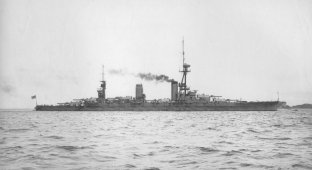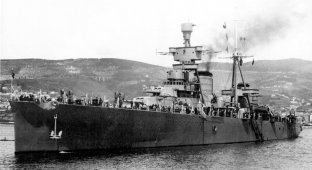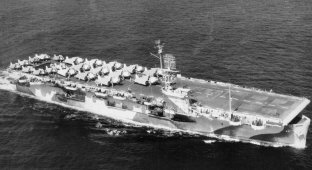It was supposed to be better than Richelieu, but the war got in the way. Project of the battleship "Gascony" (9 photos)
In the early 1930s, French military doctrine considered Italy as a potential enemy. Until 1933, there was competition between the Italian and French fleets only in cruisers and light forces. Parity was maintained for battleships.
The construction of Dunkirk by France upset this balance. 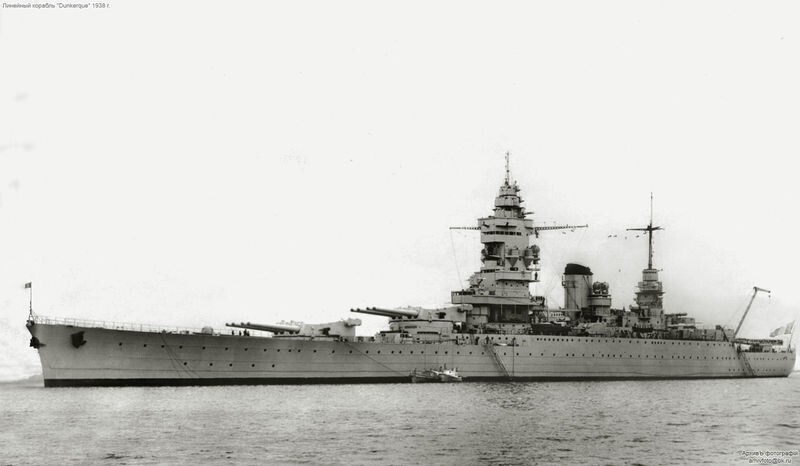
Battleship Dunkirk
In Italy, the old battleships Giulio Cesare and Conte di Cavour were returned from reserve. And in order to increase their combat qualities to an acceptable level, they hastily allocated a huge amount for the major modernization of all four battleships of this type. At the same time, the construction of two high-speed battleships of the Littorio class was announced. The French responded to this by laying down the same type of Strasbourg as Dunkirk, as well as developing designs for battleships of the Richelieu type, planned for construction in the amount of two units.
After the Nazis came to power in Germany in 1933 and the signing of the Anti-Comintern Pact in 1937, it became clear that Italy and the Third Reich planned to further strengthen military-political cooperation. Germany was also included in France's potential enemies. The Naval Department reasonably believed that in the event of a war against four new and three old French battleships of the Brittany type, Germany and Italy would be able to field a total of 11 battleships - 4 old Conte di Cavour types and 7 new ones. Therefore, it was decided to strengthen the French fleet with two more battleships.
At that time, the country's shipyards were busy building the Richelieu, Jean Bart and the aircraft carrier Joffre. Therefore, the available time was used to improve the Richelieu project, taking into account the analysis of future battleships of potential opponents.
Project development 
Exterior view of the battleship "Gascony"
During development, it was decided to leave the hull, power plant and armor virtually unchanged, but to improve the layout and composition of the weapon systems. Several projects were proposed for consideration by the commission, one of which was accepted as the design for the battleship Clemenceau. It was identical to "Richelieu" and "Jean Bar", but also had auxiliary artillery of 12 152 mm guns and 12 100 mm anti-aircraft guns.
And for the battleship Gascony they decided to use a completely different artillery layout. The main battery turrets were placed not in the bow, but in the bow and stern. In addition, they changed the layout of the auxiliary artillery towers, strengthened the anti-aircraft weapons and increased the length of the armor belt by 4.5 meters with a slight decrease in its thickness. Due to the change in the location of the main battery towers, it was necessary to move the superstructure to the bow, change the location of the hangar and aircraft equipment, and also completely redesign the interior layout.
The keel of the ship was supposed to be laid in mid-1939, but since this date depended on the launching dates of battleships already under construction, the possibility of delaying the start of construction until the summer of 1940 was envisaged. In the end, this is what happened. Only in April 1940 did France begin procuring materials to begin construction of the battleship Gascony. But in May 1940, the Third Reich invaded its territory, and in June Saint-Nazaire was already captured by the Germans. All supplies prepared for Gascony were confiscated by the occupation authorities. The project was buried and was not resumed after the war.
Description of design
Frame 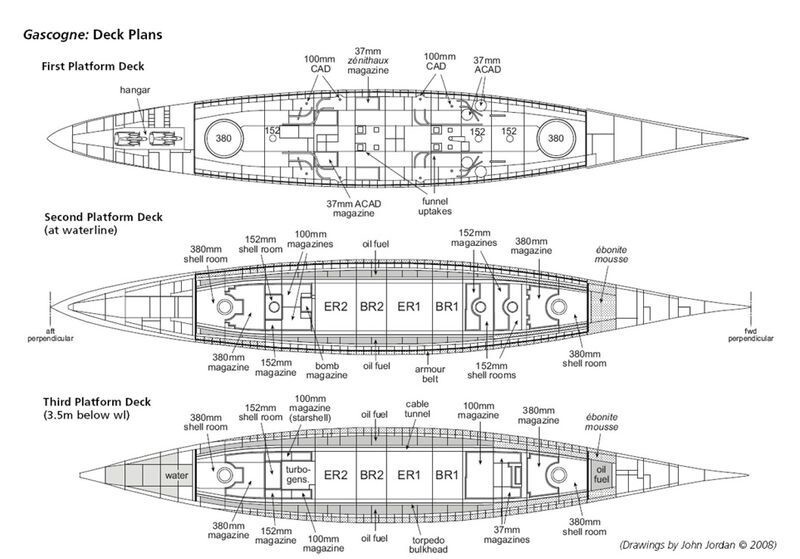
Deck plan of the battleship Gascony
The hull of the battleship "Gascony" was generally identical to the battleships of the "Richelieu" type: with a longitudinal-transverse power system, extensive use of electric welding, increased length and high side. With a calculated standard displacement of 35,000 tons, its length was 247.9 m, width 33.1 m, and draft 9.82 m.
To increase the survivability of the ship, a developed system of watertight bulkheads was designed. In total, the internal layout included 21 sealed compartments, and the lower compartments did not even have doors. To move the crew there, the project provided for special pipes that were highly resistant to deformation.
The bow superstructure was shifted to the midships, as the location of the main battery turrets changed. This was the most noticeable visual difference from the Richelieu-class battleships.
Power point
The power plant also remained unchanged. It was a four-shaft power plant with 4 Parsons TPAs and Sural boilers, arranged in a layered pattern to increase survivability. The total power of the power plant reached 155,000 hp. in normal mode and 175,000 hp. in afterburner, which provided the battleship with a maximum speed of 33 knots. With a standard fuel supply of 6,900 tons, the cruising range was 10,000 miles at an economical 12-knot speed or 3,000 miles at maximum speed. 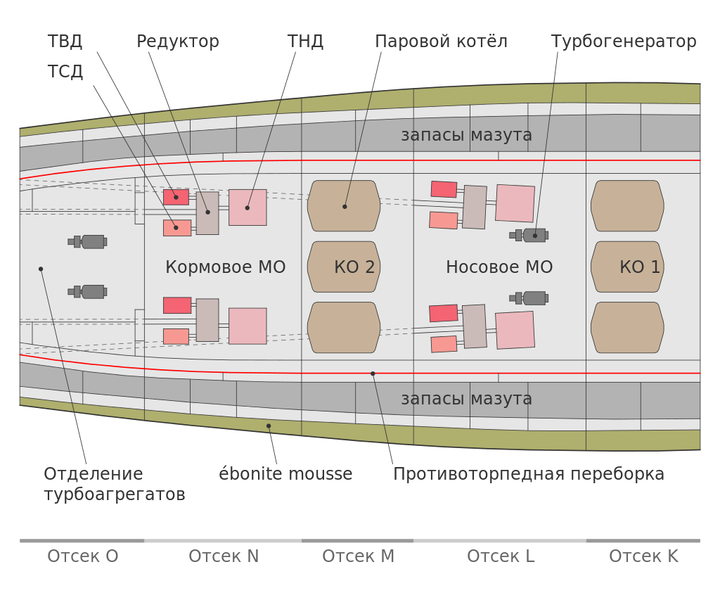
Diagram of the main power plant of battleships of the Richelieu type
Booking
In general, the reservation scheme remained similar to Richelieu and was designed according to the “all or nothing” system. But due to a change in the location of the artillery towers, the length of the main armor belt had to be increased by almost 3.5 m - up to 135.1 m.
The main armor belt plates were located at an angle of 15°. With a total height of the slab of 6.25 m, the lower part was 2.56 m below the waterline. The plates themselves had differentiated thicknesses. The upper part, 5.19 m high, was 327 mm thick, and the underwater part was 177 mm thick. Behind the armor belt there was a 60-mm teak lining, which prevented cracking of the armor and took on part of the impact load.
At the ends of the citadel there were two armored traverses with a thickness of 355 mm in the central part. In the upper and lower parts, the armor thickness decreased to 233 mm. Another armored traverse was installed behind the steering gear compartment.
Horizontal protection was supposed to provide protection against aircraft bombs weighing up to 500 kg. The main armored deck, made of viscous uncemented armor on a 15-mm lining, was laid on the upper edge of the main armor belt slabs. In the area of boiler rooms and engine rooms, its thickness reached 150 mm, in the area of artillery cellars - 170 mm. Below the main armored deck, a lower 40-mm armored deck was installed, attached to the main armored belt on 50-mm bevels.
The tiller compartment had its own protection system. In the rear, on top and on the sides it was covered with 150 mm armor plates, and a 50 mm armor plate was installed in front. The shafts themselves were protected by a 100 mm deck. 
Reservation of the battleship "Gascony"
The double bottom ran along the entire length of the hull, but in the area of the main battery cellars it was made of a triple bottom. The vertical anti-torpedo bulkhead had a thickness of 18 mm; in the area of artillery magazines its thickness increased to 50 mm. In addition, the space between the armor belt and the skin itself was filled with a special porous rubber-based compound called “Ebonite Mousse”.
The armoring of the cabin was made of vertical armor plates with a thickness of 340 mm in the frontal part and 280 mm in the stern. All doors were also armored, 280 mm thick. The roof of the first and second compartments was made of horizontal 170 mm slabs. In the cabin itself there was an additional 160 mm communication pipe and cable channels with 20 mm armor.
The main battery turrets in the frontal part had cemented armor of 430 mm at an angle of 30°, and the sides were protected by 300 mm of armor. The roof consisted of two parts. The front part was inclined and had a thickness of 195 mm, and the horizontal rear part was 175 mm thick. The back of the towers was protected by 270 mm thick sheets. The thickness of the outer barbette reached 405 mm of cemented armor on a 20-mm base of unarmored steel, and in the space below deck - 85 mm. At the rear of each turret there was a rangefinder station protected by 115 mm chromium-nickel steel armor. 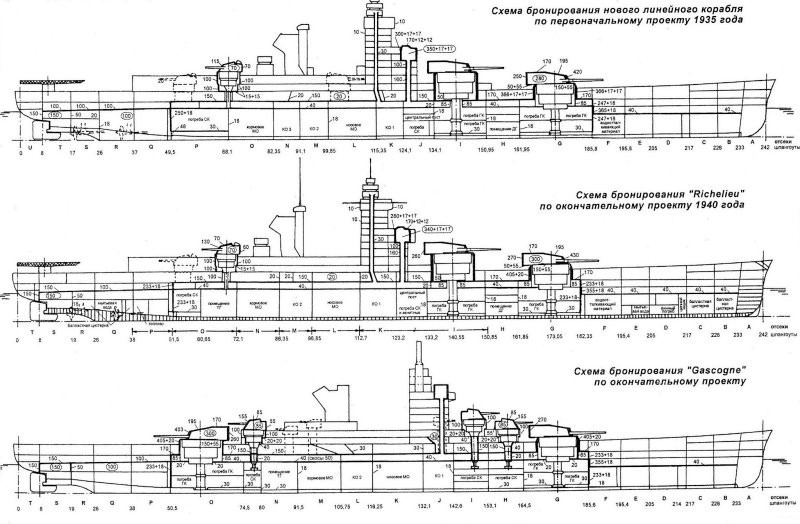
Comparison of armor of French battleships of different series
The auxiliary artillery turrets received lighter armor than those on the Richelieu to compensate for the increased weight of the guns themselves. In the frontal part, 130 mm chromium-nickel armor was located at an angle of 45°, the vertical walls were 75 mm thick on the sides and 60 mm at the rear. The roof, located at a slight angle, was protected by 70 mm armor. Barbettes were made from 100 mm nickel armor.
Armament
Main caliber
The main battery artillery was housed in two four-gun Saint-Chamon turrets, located in the bow and stern. Each turret consisted of two autonomous compartments, separated by a 45-mm armored partition, with its own cradle and ammunition supply system.
380 mm gun 380 mm/45 Model 1935 of the battleship Richelieu in Brest
Modele 1935 guns with a caliber of 380 mm and a barrel length of 45 calibers were manufactured using advanced technologies at that time, and therefore were distinguished by high survivability and excellent ballistics. At a maximum vertical aiming angle of +35°, the firing range of an 890-kg armor-piercing projectile reached 41 km. Armor penetration was one of the highest in its class and amounted to 514 mm of vertical armor at a distance of 15 km and 259 mm at a distance of 35 km, surpassing those of British, German and American guns of the same caliber. The practical rate of fire was 1.0-1.3 rounds/min per barrel.
Auxiliary artillery
As mine countermeasures artillery, the Gascony was to carry three three-gun Modele 1936 DP turrets with 152 mm Modele 1930 guns, designed for light cruisers of the La Galissoniere and Emile Bertin type. The auxiliary artillery towers were placed in a linear-elevated pattern: two behind the bow and one in front of the aft main gun turret. This arrangement provided the most convenient firing sectors without dead zones.
The 152-mm Modele 1930 gun with a 55-caliber barrel could fire semi-armor-piercing projectiles weighing 57.1 or 56 kg at a distance of 26.8 km at an elevation angle of 45°. Also, due to the maximum elevation angle of 90°, these guns could theoretically be used to conduct anti-aircraft fire with an altitude reach of 14 km. But due to the impossibility of loading at an angle above 75° and the low pointing speed, as well as the practical rate of fire of 6.5 rounds/min. they could only conduct barrage fire on the barrel. 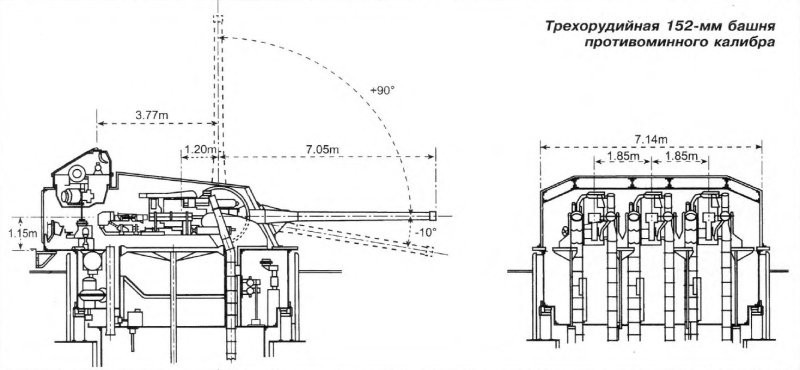
Three-gun 152 mm anti-mine caliber turret
Flak
At the corners of the superstructure there were 8 twin mounts of universal 100-mm Modele 1930 guns, two in each corner. Each installation was covered with a 30-mm armor shield and could fire high-explosive and semi-armor-piercing shells at a distance of up to 15.8 km against sea targets or 10 km against air targets. The practical rate of fire at sea targets was 16 rounds/min. per barrel, airborne - 10 rounds/min.
Short-range air defense was represented by three quadruple and four twin mounts of 37-mm Modele 1933 anti-aircraft semi-automatic guns, as well as 9 quadruple mounts of 13.2-mm Hotchkiss Modele 1929 anti-aircraft machine guns. The insufficient magazine capacity of 37-mm machine guns did not allow for a rate of fire above 20 rounds./min. on the trunk. The lethality of the 13.2 mm machine guns was also low.
Aviation weapons
Below the deck in the aft part behind the main gun turret No. 2 there was a hangar where two SNCAC Farman NC 420 reconnaissance seaplanes were to be stored. Another one was in ready condition on the catapult. The planes were lifted onto the deck by a lift and then launched from a catapult.
Project evaluation 
Scale model of the battleship "Gascony"
In general, the Gascony, in terms of its characteristics, was a fairly balanced and powerful ship, capable of equal resistance to the latest Italian battleships of the Littorio class and the German Bismarck class. Its guns had some of the highest armor penetration and firing range among their classmates. Good armor protection and rational layout of the interior ensured excellent survivability. Proof of this is the battle of Casablanca, when the practically motionless battleship Jean Bart, which had the same armor scheme as the Gascony, withstood several dozen hits from 16-inch shells and was disabled only after two well-aimed bomb hits. But after the outbreak of World War II, building such ships from scratch turned out to be an impossible task for the French economy. In addition, the combat value of battleships, as the last years of the war showed, was increasingly declining compared to aircraft carriers. Therefore, “Gascony” remained just another project.












